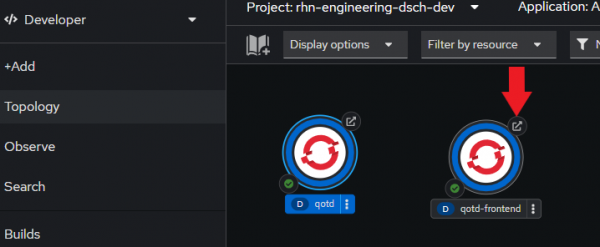Page
Create your front-end application

In this lesson, you will combine what you learned in Lesson 1 to complete your server-side injection.
What you need
- A Developer Sandbox account
- The
occommand line interface - A web browser to access your sandbox dashboard
What you will do
- Start a front-end application
- View the results
Create your front-end application
Using the URL you saved from of the previous lesson, run the following two commands at the command line:
oc new-app https://github.com/redhat-developer-demos/qotd-frontend –strategy=docker –env QOTD_API_URL={insert url here} --labels=tier=frontend,language=html,qotd=frontend,sandbox=environment-variables
Here’s an example:
oc new-app https://github.com/donschenck/qotd-frontend --strategy=docker --env=QOTD_API_URL=https://qotd-rhn-engineering-dsch-dev.apps.sandbox-m3.1530.p1.openshiftapps.com/quotes/random --labels=tier=frontend,language=html,qotd=frontend,sandbox=environment-variables
oc create route edge --service=qotd-frontend --port=8080
View the results
Switch to the OpenShift web dashboard and, in the Developer/Topology view, select the URL icon to view the front-end application in your browser (Figure 1).

In the browser, you will see the URL listed at the top (Figure 2). Select Get another random quote to retrieve a quote from the back-end service.

The quote will appear (Figure 3).

Works for other languages too
This technique works for other languages as well. Here’s an example written in Python.
The Dockerfile:
# UBI Builder
FROM registry.access.redhat.com/ubi9/ubi:9.2-755 AS ubi-builder
# create rootfs directory where to copy the final filesystem
RUN mkdir -p /mnt/rootfs
# install runtime tools (including python)
RUN yum install --installroot /mnt/rootfs coreutils-single curl shadow-utils \
findutils python3.11 pip \
--releasever 8 --nodocs -y && \
yum --installroot /mnt/rootfs clean all && \
rm -rf /mnt/rootfs/var/cache/* /mnt/rootfs/var/log/dnf* /mnt/rootfs/var/log/yum.*
# use the final root filesystem as default directory
WORKDIR /mnt/rootfs
COPY ./start.sh /mnt/rootfs
RUN chmod +x /mnt/rootfs/start.sh
FROM scratch as python-builder
COPY --from=ubi-builder /mnt/rootfs/ /
# Create frontend user
RUN groupadd -g 1000 frontend && useradd -u 1000 -g frontend -G root frontend
# Install python dependencies for the app
COPY requirements.txt /app/requirements.txt
RUN pip install -r /app/requirements.txt
# copy the app
COPY app.py /app/app.py
COPY templates /app/templates
COPY static /app/static
RUN find /app -exec sh -c "chgrp 0 {}; chmod g+rwX {}" \;
# Use scratch image and then copy python app fs
FROM scratch
COPY --from=python-builder / /
# expose frontend port
EXPOSE 5000
USER 1000
WORKDIR /app
ENV FLASK_APP=app.py FLASK_RUN_HOST=0.0.0.0
# start flask
ENTRYPOINT ["/start.sh"]
The file “start.sh”:
sed -i "s/{APP_SERVER}/${APP_SERVER}/" /app/app.py
flask run
You can view the entirety of this Python example at the GitHub repo.
Developer notes
- The back-end application is written in Go.
- The front-end application is written in HTML and JavaScript.
Move it, remove it, improve it
Move
You can download all of the YAML files associated with this application and use them to move it to another OpenShift instance by using the Export Application button in the upper right corner of the OpenShift dashboard.
Remove
You can this activity by using the following command:
- To remove the objects associated with this learning path from your sandbox:
oc delete all -l sandbox=environment-variables - You can remove parts of this activity by using labels. Learn about labels with the Using Red Hat OpenShift labels learning path.
Improve
Some ideas to improve or alter this activity:
- Write your own back-end function in a different language.
- Alter the back-end function to read from a database.
- Write the front end in another language.
- Make the back end into a serverless function.
